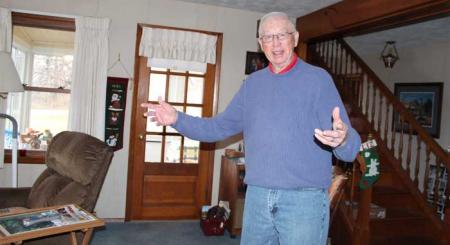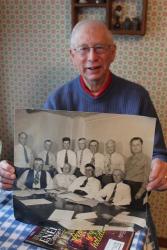Thirteen Rock County farmers made history 80 years ago when they laid the groundwork for rural residents to get electricity and improve the quality of their lives. The history of Rock County Electric Cooperative Association, now Rock Energy Cooperative, is filled with milestones, significant happenings, and thousands of smaller achievements that have taken place since 1936. Click here to read more.
To learn more about the history of Rock Energy Cooperative, you can download Architects of Rural Progress, a booklet published in 2011 to celebrate the co-op's 75th anniversary. The video above, also produced in 2011, highlights the co-op’s early days and shows how it has grown through the years. We hope you enjoy learning more about the history of your co-op.
'We're Going to Get Lights Someday'
Stan Dybevik remembers when the lights came on for the first time in his childhood home.
“That was a tremendous day,” he said. “I can remember someone switched the light and it came on up in the ceiling. It was just a bulb hanging down at that time.”

Stan Dybevik remembers when electricity came to his childhood home.
”That was a tremendous day.”
Dybevik doesn’t recall the exact date but guesses it was either 1937 or 1938 when he was 8 or 9. He still lives in that house located northwest of Orfordville and even has one of the kerosene lanterns that he once used as light for reading.
“The main thing was getting lights and then all kinds of labor-saving things,” Dybevik said. “One of the first purchases that my dad made was a Montgomery Ward refrigerator. That was one of the big items, and the other one for my mother was an electric wringer washing machine.”
From there, it was an electric fry pan, iron, toaster, stove—“all these little conveniences that came along,” he said. “None of these things just came boom, boom, boom, and we’re going to get this, this, this, and this. We couldn’t afford it. It was piecemeal.”
“All these little conveniences” played a vital role in improving the quality of life for rural folks. Farmers at the time relied on hand- or animal-powered equipment, which made their work difficult and their days long.
“It was just a big uplift and a happy moment for us here as in so many other rural homes,” Dybevik said about finally getting electricity. “This is the way rural America was.”
He is proud of the role his father, J.B. Dybevik, played in forming Rock County Electric Cooperative Association, which is now Rock Energy Cooperative. His father’s signature is on the articles of incorporation filed in 1936.

A photo from the co-op’s early days
shows his father, J.B. Dybevik,
seated in the front row on the right.
“It didn’t mean a lot to me at the time,” Dybevik said. “I can just remember him saying, ‘We’re going to get lights someday, and we’re out trying to get people signed up to do this.’”
J.B. Dybevik served on the co-op’s board of directors for 25 years, from 1936 to 1961. When young Stan accompanied his father to annual meetings, he couldn’t predict that he too would become a co-op director. The younger Dybevik served 40 years, from 1971 to 2011.
The most significant outcome of extending electricity to rural America was providing farmers with labor-saving devices, Dybevik said.
“When you think what electricity has done and how it’s changed—it was a terrific thing that Roosevelt did with that executive order in 1935,” he said. “It’s just unbelievable.”
Dybevik was referring to President Franklin D. Roosevelt signing Executive Order 7037, which established the Rural Electrification Administration as an emergency agency. A year later, Congress approved the Rural Electrification Act of 1936, moving the agency to a more permanent status and providing low-interest loans to achieve rural electrification.
“It’s amazing to see what has happened in the rural areas,” he said. “It’s just a completely changed rural America. I don’t know how much the city people really appreciated that or understood that because they had electricity. I’m just thankful that there were people like my dad and others in this co-op and all over rural America that they were able to do the work.”
In addition to providing farmers with labor-saving devices, electricity also improved communication and education in rural areas.
“Radio was one of the first things,” Dybevik said. “That brought the world to us.”
He noted that investor-owned utilities had the same opportunity as electric cooperatives to apply for low-interest loans from the REA, but they didn’t.
“They just didn’t have the foresight to see down the line what this was going to do,” he said. “And that’s probably understandable. You have a house here and a farm there. You go several miles and have another one or two. You have to get wires strung out all over there, and this is really going to cost some money.”
Cooperatives were important in the 1930s because they brought electricity to rural America, and they remain relevant today, Dybevik said. They offer a more personal approach because they are operated by members who have a financial stake in the co-op, he said. While investor-owned utilities are concerned about producing a profit for shareholders, energy co-ops have only one goal: keeping the lights on safely, reliably, and affordably.
“I’m certainly very happy and proud to be a part of it over all these years,” he said. “I certainly wish continued success to the co-op. It got this far—80 years—we can’t give it up now.”
